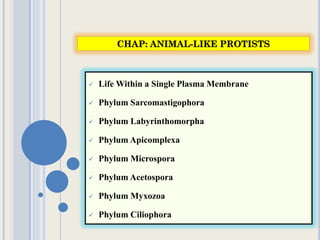
Lecture No 3--Life within single cell.pdf
- 1. CHAP: ANIMAL-LIKE PROTISTS Life Within a Single Plasma Membrane Phylum Sarcomastigophora Phylum Labyrinthomorpha Phylum Apicomplexa Phylum Microspora Phylum Acetospora Phylum Myxozoa Phylum Ciliophora
- 2. Protozoa have unicellular (cytoplasmic) organization. But they are not simple organisms. Often, they are more complex than any particular cell in higher organisms. Some individual protozoans come together to form colonies. The individuals in a colony are not dependent on one another for most functions. However, some protozoan colonies are complex. Their individual cells become specialized. Therefore, it becomes difficult to differentiate between a colony and a multicellular organism. LIFE WITHIN A SINGLE PLASMA MEMBRANE
- 3. The bodies of protozoans are supported by pellicle and cytoplasm. (a) A regular arrangement of microtubules is called the pellicle. Pellicle underlies the plasma membrane of many protozoa. The pellicle is a rigid structure. It maintains the shape of the protozoan. But it is also flexible. (b) Cytoplasm: The cytoplasm of a protozoan is differentiated into two regions: The portion of the cytoplasm just beneath the pellicle is called ectoplasm. It is relatively clear and firm. The inner cytoplasm is called endoplasm. It is granular and more fluid like. Maintaining Homeostasis in Protozoans Protozoans maintain homeostasis by following methods: 1. Support
- 4. Fig: A Protozoan Protist. This drawing of a stylized protozoan with a flagellum illustrates the basic protozoan morphology.
- 5. The maintenance of water and salt balance in the body is called osmoregulation. Most marine protozoa have solute concentrations similar to that of their environments. Freshwater protozoa, however, must regulate the water and solute concentrations of their cytoplasm. Water enters freshwater protozoa by osmosis. Contractile vacuoles remove this excess water. In some protozoa, contractile vacuoles form by the coalescence of smaller vacuoles. In others, the vacuoles are permanent organelles that collecting tubules radiating into the cytoplasm fill. Contracting microfilaments have been implicated in the emptying of contractile vacuoles. 2. Osmoregulation
- 6. There are different methods of ingestion of food. (i) Most protozoans absorb dissolved nutrients by active transport. (ii) Some protozoan ingests whole or particle of food by endocytosis. It forms food vacuole. (iii) Some protozoa ingest food through cytopharynx. 3. Ingestion of Food
- 7. Digestion and transport of food occurs in food vacuoles. These food vacuoles are formed during endocytosis. (i) Food vacuoles fuse with Lysosomes. (ii) These lysosomes contain enzymes. The change of enzyme and acidity will help in digestion. (iii) These food vacuoles circulate through the cytoplasm and distribute the products of digestion. (iv) The vacuoles are called egestion vacuoles after completion of digestion. They release their contents by exocytosis. Sometimes a temporary pole is formed at a specialized region of the plasma membrane or pellicle. This pore is called the cytopyge. 4. Process of Digestion
- 8. The protozoans have small size. They have a large surface area in proportion to their volume. It helps in gas exchange or excretion. Both gas exchange and excretion occur by diffusion across the plasma membrane. i. Gas exchange involves absorption of oxygen and elimination of the carbondioxide. ii. Excretion is the elimination of the nitrogenous waste. iii. By product in protozoa is mostly ammonia. 5. Respiration and Excretion
- 9. Both asexual and sexual reproduction occurs among the protozoa. 1) ASEXUAL REPRODUCTION Binary fission Budding Multiple Fission or Schizogony 2) SEXUAL REPRODUCTION 6. Reproduction
- 10. 1. Binary fission In binary fission, mitosis produces two nuclei that are distributed into two similar- sized individuals when the cytoplasm divides. During cytokinesis, some organelles duplicate to ensure that each new protozoan has the needed organelles to continue life. Depending on the group of protozoa, cytokinesis may be longitudinal or transverse 2. Budding It is another limp of asexual reproduction. Mitosis occurs during budding. It is followed by the incorporation of one nucleus into a cytoplasmic mass. This cytoplasmic mass is much smaller than the parent cell.
- 11. 3. Multiple Fission or Schizogony In this case, a large number of daughter cells are formed bv the division of a single cell. Multiple mitotic divisions occur in a mature cell in schizogony. Large number of nuclei are formed. Then cytoplasmic divisions occur. Cytoplasmic divisions result in the separation of each nucleus into a new cell.
- 12. Fig: Asexual Reproduction in Protozoa. Binary fission begins with mitosis. Cytoplasmic division (cytokinesis) divides the organelles between the two cells and results in two similarly sized protozoa. Binary fission is (a) longitudinal in some protozoa (e.g., mastigophorans) and (b) transverse in other protozoa (e.g., ciliates).
- 13. Fig: Binary Fission of the Ciliate, Stentor coeruleus. (a,b) Fission includes the division of some surface features—in this case, cilia modified into a bandlike structure called a membranelle (M). F designates the frontal field. The arrow in (b) shows the beginning of a fission furrow. (c,d) Fission is completed by division of the cytoplasm.
- 14. Sexual reproduction requires gamete formation and the subsequent fusion of gametes to form a zygote. In most protozoa, the sexually mature individual is haploid. Gametes are produced by mitosis, and meiosis follows union of the gametes. . Sexual Reproduction
- 17. Subphylum Mastigophora • Class Phytomastigophorea • Class Zoomastigophorea Subphylum Sarcodina Superclass rhizopoda • Class lobosea Subphylum Actinopoda Subphylum Opalinata PHYLUM SARCOMASTIGOPHORA
- 18. CHARACTERISTICS: 1. Unicellular or colonial 2. Locomotion by flagella, pseudopodia, or both 3. Autotrophic, saprozoic, or heterotrophic 4. Single type of nucleus 5. Sexual reproduction (usually) PHYLUM SARCOMASTIGOPHORA
- 19. FLAGELLAR LOCOMOTION Members of the subphylum Mastigophora use flagella in locomotion. Flagella may produce two-dimensional, whiplike movements or helical movements that push or pull the protozoan through its aquatic medium. SUBPHYLUM MASTIGOPHORA: